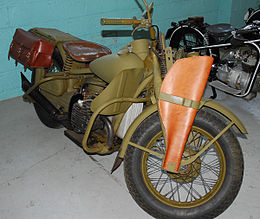 | |
| Manufacturer | Harley-Davidson |
|---|---|
| Production | 1942[1] |
| Assembly | Milwaukee, Wisconsin, USA |
| Class | Military motorcycle |
| Engine | 45 cu in (740 cc) SV flat-twin[1][2] |
| Bore / stroke | 3.063 in × 3.063 in (77.8 mm × 77.8 mm)[3] |
| Compression ratio | 5.7:1[1][2] |
| Top speed | 65 mph (105 km/h)[1] |
| Power | 23 hp (17 kW) @ 4,600 rpm[1][2][4] |
| Ignition type | 6 V battery and coil,[1] no distributor[2] |
| Transmission | 4-speed foot shift[2] |
| Frame type | tubular steel double cradle[1] |
| Suspension | Front: leading link fork Rear: plunger[1][2] |
| Brakes | Drums front and rear[1][2] |
| Tires | 4.00 x 18[1][2] |
| Wheelbase | 57.5 in (1,460 mm)[1] |
| Fuel capacity | 4.1 US gal (15.5 L; 3.4 imp gal)[1] |
| Oil capacity | 2 US qt (1.9 L)[1] |
The Harley-Davidson XA (Experimental Army) was a flat-twin, shaft drive motorcycle made by Harley-Davidson for the US Army during World War II.[4]
Development and production[edit]

During WWII, the U.S. Army asked Harley-Davidson to design a specification of a motorcycle much like the BMWs used by German forces, with shaft drive, a boxer engine, and several other features that made the BMWs exceptionally reliable and low-maintenance machines. Harley was already producing the WLA, based on its traditional 45-degree V-twin but the army specifically wanted the one feature that the WLA didn't have: shaft drive. So the company produced the XA, whose engine and drivetrain were based on the flathead BMW R71 (1938–1941) [3][5] versus the overhead valve (OHV) BMW R75 (1941–1946). 1000 XAs were produced for evaluation.[2][3] By the time production had begun, it was clear that the Jeep was the Army's general purpose vehicle of choice.[4] No more XAs were ordered after the initial order of 1000.[3] The less advanced but cheaper WLA was considered sufficient for its limited roles.[1]
In 1943, the XA's leading link fork[1][2] was replaced with Harley-Davidson's first telescopic fork.[4]
Similar motorcycles in other countries[edit]
From 1942, the BMW R71 would serve as the basis for the IMZ-Ural and KMZ-Dnepr M72 (U.S.S.R./Russia), and from 1956 the Chang Jiang CJ750 (China) which likewise pressed it into military service though parts should not be considered interchangeable across marques despite visual similarities.
Cooling[edit]
According to the American Motorcyclist Association's Motorcycle Hall of Fame Museum, regarding the World-War-II-vintage Harley-Davidson XA, which has an opposed twin engine — "Mechanically, the large cooling fins stuck straight out in the breeze, reportedly keeping the XA’s oil temperature 100 °F (38 °C) cooler than a standard Harley 45."[4] The latter was a transversely mounted V-twin, in which the air stream cannot reach the cylinders, especially the rear cylinder, as efficiently as a longitudinally mounted flat twin. The use of "transverse" and "longitudinal" here follows motor car convention based on crankshaft alignment. However, with motorcycles the convention is based on width - hence cylinder orientation. Therefore, a flat or v-twin with left and right cylinders is transverse but with front and rear cylinders it is longitudinal.
-
1942 Harley-Davidson XA on display at the California Automobile Museum
-
Harley-Davidson XA engine
Related projects[edit]
Though the XA motorcycle was "dead" as far as the military was concerned for full-blown production, both the side-valve and overhead-valve versions of the XA engine were explored according to Jerry Hatfield in his 1990 book "Inside Harley-Davidson" published by Motorbooks International. A 45 cu in (740 cc) overhead-valve version XA motor was sent to Detroit Wax Paper for testing as a generator set. OHV XA motors of 49 cu in (800 cc), with transmissions, were sent to Willys-Overland for testing as well as two blower-cooled XA motors for generators to be tested on tanks in 1943. There was even a Servi-Car prototype made called "The Model K" using the XA engine instead of the G motor planned for the 1946 model year.
See also[edit]
References[edit]
- ^ a b c d e f g h i j k l m n o Rafferty, Tod (1997-03-23). "Two: The Middle Kingdom". Complete Harley Davidson: A Model-by-Model History of the American Motorcycle. Crestline Imprints. pp. 56–57. ISBN 0-7603-0326-6. Retrieved 2012-08-05.
- ^ a b c d e f g h i j Hatfield, Jerry (2006-02-08). "H". Standard Catalog of American Motorcycles 1898-1981. Krause Publications. pp. 182–185. ISBN 0-8734-9949-2. Retrieved 2012-08-05.
The XA was a BMW clone machined to American dimensions and fitted with H-D tanks and fork.
- ^ a b c d Leffingwell, Randy (2003-12-01). "Chapter 7: The First Knuckleheads". Harley-Davidson History & Mystique (revised ed.). Crestline Imprints. pp. 64–67. ISBN 0-7603-1541-8.
In addition, the XA was the first production Harley to feature front and rear suspension.
- ^ a b c d e f "Motorcycle Hall of Fame Museum: 1942 Harley-Davidson XA". Motorcyclemuseum.org. Archived from the original on 2012-11-14. Retrieved 2011-02-25.
Wood, Bill, ed. (March 1999). "Classics: 1942 Harley-Davidson XA". American Motorcyclist. 53 (3). Pickerington, OH US: American Motorcyclist Association: 127. ISSN 0277-9358. Retrieved 2012-08-06.Mechanically, the large cooling fins stuck straight out in the breeze, reportedly keeping the XA's oil temperature 100 degrees cooler than a standard Harley 45.
- ^ "BMW Group Classic".
External links[edit]
- Army Tests Experimental Shaft Driven Motorcycles September 1942, Popular Science


